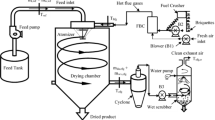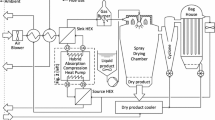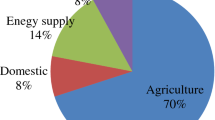Abstract
Energy conservation has become a priority for industry nowadays. Also, the process performance is evaluated according to the overall energy efficiency and the energy recovery potential. Among this work we studied the probability of recovering heat from the exhaust air out of the spray dryer unit by using high-temperature heat pump system and reuse the recovered energy for preheating the inlet air to the dryer instead of exhausting the hot outlet air into the environment. This work is applied by developing a successful model using an Aspen Plus simulation program after data acquisition for the process operating parameters of existing old plant. Then, the dryer’s main dimensions are recalculated by developing a mathematical model numerically and by using Excel software to avoid any missing data and letting the results more clearly and near to the real. The Aspen Plus simulation model was implemented using the following two major steps: (1) Spray dryer unit sizing; mass and energy balance to calculate the desired amount of air and its temperature to dry the slurry to a blown powder to get a valid simulated spray dryer compared to the recorded operating data. (2) The exhaust air from a spray dryer was moved to a heat pump system to exploit its high temperature for preheating the fresh air to the spray dryer. The developed heat pump system succeeded to recover about 17% of the waste energy and applied an economical heat pump of about 4 COP.
Access this chapter
Tax calculation will be finalised at checkout
Purchases are for personal use only
Similar content being viewed by others
Abbreviations
- PFD:
-
Process Flow Diagram
- Gs:
-
Air mass flowrate (kg/hr)
- Y1:
-
Inlet air humidity (Kg moisture/Kg air)
- Y2:
-
Outlet air himidity (Kg moisture/Kg air)
- Ls:
-
Solids mass flowrate (Kg/hr)
- X1:
-
Moisture in inlet slurry (kg moisture/Kg solids)
- X2:
-
Moisture content in outlet dried powder (Kg moisture/kg solids)
- T1:
-
Hot air inlet temperature
- T2:
-
Air outlet temperature
- H1:
-
Enthalpy of inlet air
- H2:
-
Enthalpy of outlet air
- HL1:
-
Enthalpy of inlet Slurry
- HL2:
-
Enthalpy of outlet dried powder
- t 1:
-
Slurry inlet temperature
- t 2:
-
Dried powder outlet temperature
- GWP:
-
Global Warming Potential
References
Ai, S., Wang, B., & Li, X. (2016). Analysis of a heat recovery system of the spray-drying process in a soy protein powder plant. Applied Thermal Engineering, 103, 1022–1030.
ASPEN Plus guidlines, Drying Curve. (n.d.).
Chi, J., & Didion, D. (1982). A simulation model of the transient performance of a heat pump. International Journal of Refrigeration, 176–184.
Chua, K., Chou, S., & Yang, W. (2010). Advances in heat pump systems: A review. Applied Energy, 87(12), 3611–3624.
Dincer, I., & Rosen, M. (2015). Energy analysis of heating. Elsevier.
Filkova, I., & Mujumdar, A. (1995). Handbook of industrial drying. Marcel Dekker Inc.
Golman, B., & Julklang, W. (2014a). Analysis of heat recovery from a spray dryer by recirculation of exhaust air. Energy Conversion and Management, 88, 641–649.
Golman, B., & Julklang, W. (2014b). Simulation of exhaust gas heat recovery from a spray dryer. Applied Thermal Engineering, 73, 899–913.
Hepbasli, A., & Kalinci, Y. (2009). A review of heat pump water heating systems. Renewable and Sustainable Energy Reviews, 1211–1229.
Holland, C., & McCann, J. (2007). Heat recovery in spray drying systems. International Journal of Food Science & Technology, 15, 9–23.
Jonathan, C. (2017). Control of detergent properties in a spray dryer process.
Krokida, M., & Bisharat, G. (2004). Heat recovery from dryer exhaust air. Drying Technology, 1661–1674.
Marshal, W., & Selter, E. (1950). Principle of spray drying (Vol. 46). American Institute of Chemical Engineers.
Masters, K. (1985). Spray drying handbook. George Godwin Ltd.
Moisia, H., & Rieberer, R. (2017). Refrigerant Selection and Cycle Development for a High Temperature Vapor Compression Heat Pump. 12th IEA Heat Pump Conference. Austria.
Mujumdar, A. (2006). Handbook of industrial drying. Taylor & Francis Group.
Patel, M., & Suthar, A. (2009). Spray drying technology: An overview. Indian Journal of Science and Technology, 44–47.
Patel, S., & Bade, M. (2019). Energy analysis and heat recovery opportunities in spray dryers applied for effluent management. Elsevier, 186, 597–609.
Refrigerants. (n.d.). Retrieved March 2020, from Industrial heat pumps: https://industrialheatpumps.nl/en/how_it_works/refrigerants/.
Suryanarayana, A. (2002). Mass transfer operations. New Age International.
Vehringa, R., Foss, W., & Lechuga-Ballesteros, D. (2007). Particle formation in spray drying. Journal of Aerosol Science, 728–746.
Author information
Authors and Affiliations
Corresponding author
Editor information
Editors and Affiliations
Rights and permissions
Copyright information
© 2022 The Author(s), under exclusive license to Springer Nature Switzerland AG
About this chapter
Cite this chapter
Nafady, H.H., Mansour, M.S., El-Gayar, D., Morsy, A. (2022). Energy Recovery from Spray Dryer Exhaust Air Using High-Temperature Heat Pump System. In: Rosso, F., Morea, D., Pribadi, D.O. (eds) Innovations in Green Urbanization and Alternative Renewable Energy. Advances in Science, Technology & Innovation. Springer, Cham. https://doi.org/10.1007/978-3-031-07381-6_13
Download citation
DOI: https://doi.org/10.1007/978-3-031-07381-6_13
Published:
Publisher Name: Springer, Cham
Print ISBN: 978-3-031-07380-9
Online ISBN: 978-3-031-07381-6
eBook Packages: Earth and Environmental ScienceEarth and Environmental Science (R0)




